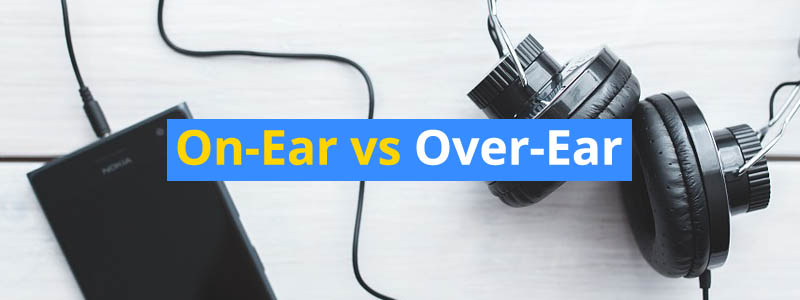On-Ear vs Over-Ear Headphones
Are you interested in buying on-ear or over-ear headphones, but aren’t sure which one will meet your needs? In this comparison guide we will give you the insight that’s required to pick between the two types of headphones. At first glance you may think there is little difference between them, but there are big differences to the wearing experience and the audio quality.
We hope that by the end of this buyer’s guide you have learnt the required info to make the right buying decision for your needs. Both the on-ear and over-ear headphone categories have plenty of models to select from, which means you’re spoilt for choice.
Advantages and disadvantages of on-ear
The on-ear format is more for the casual buyer that requires portability. This format means the earcups on placed alongside your ears as opposed to around them. Here are the advantages of such a fit:
- Not bulky: on-ear earcups tend to be significantly less bulky than the over-ear counterparts. Therefore, they are more portable and ideal for traveling or commuting to work. They are also smaller in size, which means you’ll have an easier time trying to fit them in a bag. Some on-ear designs are foldable so they can be reduced down in size even more.
- Audio quality: you may think that on-ear headphones might have relatively poor audio quality due to the lack of noise isolation. However, due to the large audio drivers the audio still sounds amazing. Also because of the fit the audio drivers are placed closer to the ears, which means audio clarity is great.
- Ventilation: the on-ear design allows for excellent ventilation because the ears are not closed inside the earcups. Therefore, you can use the headphones for hours without feeling the need to take a break since there is no sweat or heat build-up.
The advantages above means the on-ear design is a compelling choice, but there are also a few disadvantages to consider to understand the shortcomings of such a design.
- Not secure fit: some on-ear headphones do not have a secure fit, which means when moving your head you may experience dislodgement. This can be frustrating because it means you’ll have to constantly adjust the fit.
- No noise isolation: since the earcups do not go around your ears there is no way to keep ambient noise out. Therefore, you have to deal with noises around you when traveling. In loud environment such as train stations the ambient noise can get so loud that it drastically reduces the quality of your personal audio experience.
Advantages and disadvantages of over-ear design
The marketplace is flooded with excellent over-ear headphones that are manufactured by the industry leading brands. You are spoilt for choice and there are some great features such headphones have that no other format offers. Here are some of the advantages of opting for over-ear headphones
- Audio quality: the best audio can be experienced with over-ear headphones due to the sophisticated implementation of the audio drivers. If you’re after audiophile grade audio that’s suitable for professional use then you must look for options in the over-ear category.
- Noise cancelation: plenty of over-ear headphones offer noise isolation, which means the earcups naturally block out ambient noise. However, some models offer noise cancelation which produces soundwaves in order to block out the soundwaves of incoming ambient noise. This feature is ideal for traveling or blocking out noisy members of the household.
- Closed and open back design: you also have a choice between closed and open back designs. Therefore, you have the freedom to opt for the audio format that best suits your preferences.
- Comfortable fit: the over-ear design has a very comfortable fit as the earcups fit neatly around the earcups. The fit feels more secure as the headphones are locked into place. However, the comfort depends on the execution of the design by the brand so it will vary from one headphone to the next.
As you can see there are plenty of benefits to choosing over-ear headphones, but there are also some negatives too. Take the time to read through the drawbacks to have a balanced overview of over-ear headphones:
- Bulky: over-ear headphones are bulkier than the on-ear format, which means they are not as practical to use while out and about. Also the bulky fit might be cumbersome to wear for multiple hours at a time. However, if the manufacturer has implemented a lightweight design then this problem is somewhat alleviated.
- Ventilation: some over-ear designs have a lack of ventilation, which means the build-up of sweat and moisture is likely to occur after a few hours of use. Consequently, you’ll need to take a break and this can lead to a lack of productivity or enjoyment when you’re using the headphones for entertainment.
On-ear vs Over-ear
There are big differences between the two formats and the one you purchase should depend on the intended use. If you’re looking to travel, hate a bulky design, and aren’t after the best audio quality possible then you should opt for the on-ear design. The combination of the portable design that’s convenient means this is a great option.
On the other hand, if you do not want to compromise on the audio quality and need a comfortable personal audio solution that’s able to block out ambient noise then going with the over-ear format is a great choice.
Furthermore, there are some over-ear headphones designs that have many of the on-ear advantages. Some have a minimalist design that’s low in weight, so they are highly portable. You need to look at the product description carefully to determine the specific features each headphone has regardless of what earcup format is implemented.

